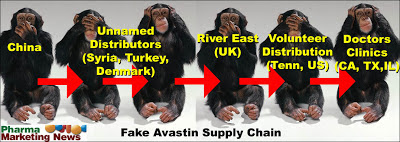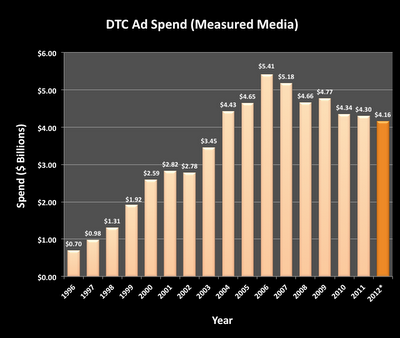It’s appropriate that I present a few pharma industry predictions for 2013 in the last post of the year to Pharma Marketing Blog. To compile the following list, I used data from surveys, looked at the past year as an indication of what may be important in 2013, and reviewed predictions from the usual suspects (e.g., people in the #pharma100 list).
It’s also a good time to revisit a survey I started a couple of years ago that attempted to predict future healthcare market scenarios that would impact the drug industry. The survey asks respondents how likely it is for certain events or conditions to unfold in the next 5 to 8 years (ie, 2012 to 2019). You can see some results of that survey and my comments here.
So, here are my predictions for 2013, in no particular order. I invite you to provide feedback in comments to this post or in the surveys mentioned.
1. Direct-to-Consumer (DTC) Spending Will Continue to Decline
In the Predicting the Future of the Drug Industry: 2012 and Beyond survey, I asked respondents if broadcast (i.e., TV) Direct-to-Consumer (DTC) drug promotion will be banned or sharply curtailed by law in the U.S. This may have been a big issue back in the day, but it doesn’t seem to be center stage right now. Less than 10% of survey respondents thought this was very likely to happen before 2019; it certainly would not happen in the coming year when lawmakers have many other pressing issues to mull over and do nothing about.
The economy, however, will continue to have a negative impact on DTC advertising causing a slow death by a thousand cuts. There already is a declining trend in traditional (broadcast TV, radio, and print) DTC spending as evidenced by this chart, the last bar of which I projected based on Lipitor going off patent and Pfizer’s subsequent abandonment of efforts to continue promoting it (see “Lipitor Holds Key to DTC Ad Spending in 2012” and “Pfizer Throws In the Lipitor Marketing Towel“).
Although the downward trend in the past may have been due to pharma falling over the “patent cliff,” that will not be the main factor impacting DTC in the future. I believe that the “fiscal cliff” will be a major factor in 2013 as ALL advertisers — not just pharma — cut back on advertising. And it doesn’t matter if we go over that cliff or not. The economy still sucks and companies as well as consumers will cut back their spending.
An article in today’s WSJ said “Even before the uncertainty in Washington, the ad business had been expecting a lackluster ad climate for 2013, thanks in part to concerns about the U.S. economy. Earlier this month, several ad holding companies, including WPP, downgraded their global and U.S. ad spending forecasts” (see “Fiscal Cliff Casts Shadow Over Madison Ave.“). “The drop in consumer confidence is concerning,” said Tony Pace, chief marketing officer at fast-food chain Subway.
You may think that pharma consumers are not prone to the same economic pressures as are consumers of other products, but you are wrong. Some of the key findings from a Rodale DTC Marketing study illustrate a trend that will result in decreased traditional DTC spending:
- People actively look to reduce their medical costs > Fewer doctor visits (21% canceled/delayed appt.)
- Switch to generic when available
- More engagement in social media
You can weigh in on this topic by taking my “Future of Rx DTC Ad Spending” survey, which asks “Regarding the trend in measured media (broadcast TV, radio, and print) DTC spending by pharma, what do you predict will be the level of spending in 2013-2016 compared to 2009-2012?”. You can see a summary of de-identified results after taking the survey yourself.
2. FDA Will NOT Issue Significant Social Media Guidance for Pharma in 2013
I already made this prediction; see “My Prediction for 2013: No Social Media Guidance from FDA.”
3. A U.S. Citizen Will Be Injured or Die Due to Counterfeit Cancer Medicine
In 2012, we saw many deaths due to one unregulated compounded medicine produced and sold in the U.S. But we may be in for a rude awakening when the market is flooded with a slew of fake cancer drugs. As reported in an article in today’s WSJ “fake Avastin that surfaced in the U.S. this year grabbed headlines, but it was just one example of a growing problem in the pharmaceutical world: the rise of counterfeit cancer drugs.
“Fake versions of costly cancer medicines have appeared in increasing numbers in Asia and the Middle East in recent years and occasionally in Europe and the U.S. In 2011, cancer drugs ranked eighth among the top 10 types of drugs targeted by counterfeiters, according to the Pharmaceutical Security Institute, an industry-funded group; five years ago, they weren’t on the list at all.
“Authorities have seized some of the fakes in warehouses or shipping containers before they reached patients. But other counterfeits have turned up in pharmacies and hospitals, in one case injuring 80 patients in Shanghai.”
If you think U.S. citizens are better protected than Chinese citizens, then you are not putting two and two together. The supply chain for cancer drugs is probably as loosely regulated as is the supply chain for compounding drugs. Doctors in the U.S. can order these drugs direct from wholesalers who compete to sell them at the lowest price. Again, due to the poor economy, many doctors are also looking to save money and increase profits by ordering drugs from shady sources. Perhaps this year one doctor will inject a counterfeit drug into a patient who may die as a result. It will be hard to prove the cause of death because of the dismal tracking of health records in this country, so while my prediction may come true, we may never hear of it!
4. Pharma Will Step Up Its Mobile Optimization Efforts
The next BIG opportunity for targeted pharma marketing to patients and physicians is mobile apps on “smart phones.” That’s one of the predictions I asked for input on in my “Predicting the Future of the Drug Industry: 2012 and Beyond” survey, which I invite you to take here. Seventy-seven percent (77%) of respondents to date agree with this prediction.
Up until now, there have been only one or two Rx branded pharma mobile apps released in the U.S. (see here and here). There may be a few more such apps in 2013, but pharma will really step up its effort to create Web sites that are optimized for mobile use.
This makes sense because (1) only about 9% of U.S. adults over the age of 18 (19% of the 45% of smartphone owners) “happen to have” apps that help them track or manage their health, and (2) Mobile Optimization Offers Better ROI Than Mobile Apps. Read more about that here.
It also makes sense because pharma is so far behind other industries with mobile optimization, the only direction it can go is “up.”
5. We Will See the Rise of the “Pharma Sales Rep Cyborg” — Part Human and Part Machine (i.e., iPad) — Which Will Save the Pharmaceutical Sales Rep from Early Extinction
A majority of respondents to my “Predicting the Future of the Drug Industry: 2012 and Beyond” survey think it is very or somewhat likely that “the role of traditional sales representative will become obsolete” by 2020. I think the “role” of sales reps has already changed and will be changed further in 2013 due to one device: the Apple iPad!
Pharma companies will develop smarter interactive detail aids for their sales reps in 2013 (e.g.., see “What Pharma Can Learn from Dexter”). This will definitely change the role of the sales rep, but I’m not sure how it will change. Most likely, smarter detail aids will allow physicians to interact with the data while the sales rep focuses on establishing rapport and making the sales pitch. That would mean that sales reps may revert back to being less knowledgeable about biology, chemistry, data, etc. All the recent talk about the “new sales model” may be turned on its head when reps become more like “sales rep cyborgs” — part human and part machine (iPad)!
I could attempt some other predictions, but I think I covered enough areas of interest to me and I hope my readers. But the long-term predictions in the “Predicting the Future of the Drug Industry: 2012 and Beyond” survey is still of interest to me and I urge you to weigh in on those.










![6 Digital Tools at the Center of Healthcare Digitalization [INFOGRAPHIC]](http://ec2-54-175-84-28.compute-1.amazonaws.com/pharma-mkting.com/wp-content/uploads/2021/04/6DigitalTools_600px-100x70.jpg)




